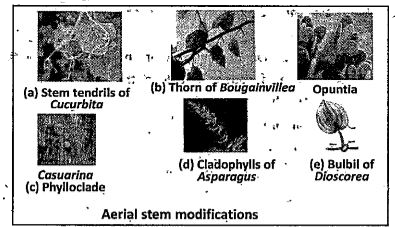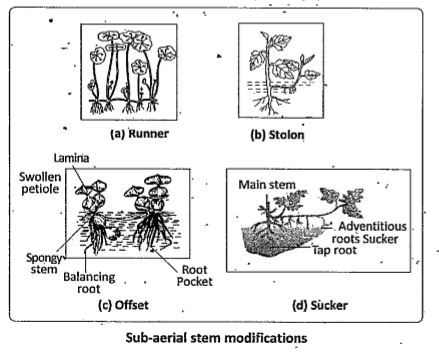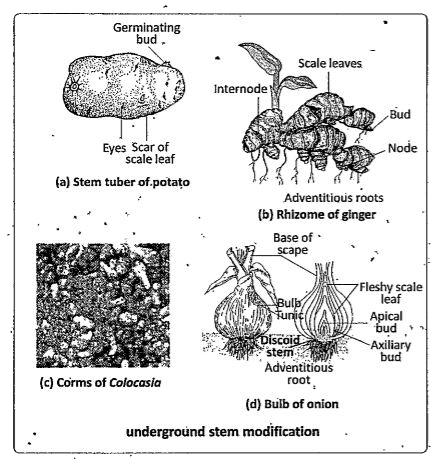When a permanent change occurs in the structure of stems to performi ņew functions suitable for the environment, it is called .stem modification
It is of three types. They are
I. Aerial stem modification
II. Sub aerial stem modification .
III. Underground stem modification
I. Aerial stem modification : Modification of aerial stems, vegetative buds and reproductive buds of a plant is called aerial stem modification.
a) Tendril: Wiry delicate organ useful for climbing are called tendril. Axillary bud modified into tendril in gourds (cucumber, pumpkin, watermelon) or terminal bud in grapevines
b) Thorn: A woody pointed structure meant for protection are called thorns. Axillary bud modified into thorn.
Eg : Bougainvillea. Terminal bud modified into thorn.
Eg: Carissa.
c) Hook : It is a woody, curved structure which helps in climbing. Ex: Artabotry.
d) Phylloclade: Leaf like stem performing photosynthesis are called phylloclade. In order to reduce transpiration the leaves are modified into scales, spines etc.
Ex: In Opuntia, fleshy green flattened stem.
In Euphorbia, fleshy, green cylindrical stem.
In Casuariņa green needle like stem. Cladode or Cladophyll is a phylloclade of limited growth.
Ex: Asparagus.
e) Bulbils : Buds which show vegetative propagation are called bulbils. Vegetative buds in Dioscorea, Floral buds in Agave.

II. Sub aerial stem modification : In some weak stemmed plants the stem remains partly aerial and partly underground. These are specialised for vegetative propagation. There are four types.
a) Runner: Underground stems in some grasses and strawberry and sub-aerial stems in oxalis spread to new nitches and form new plants when older parts die.
b) Stolon: In some plants slender branches arises grow obliquely downwards, produce roots. at the point of contact with soil. These branches are called stolons. Ex: Nerium, Jasmine etc.
c) Suckers : In plants like banana, pinę apple, chrysanthemum . part of the stem is in the soil. Underground branches grow obliquely upwards giving rise to leafy shoots. These branches are called suckers.
d) Offset: In aquatic pla Pistia and Eichhornia, a lateral branch of one internode length is called offset. At each node it bears a rosette of leaves and balancing roots at the base.

III. Underground stem modification : Functions of the underground stems are storage of food materials, perennation through unfavourable seasons and vegetative reproduction. So these are called multipurpose stem modification.
a) Rhizome: It is an underground stem which grows horizontally. It is branched. Ex : Zingiber(ginger).
b) Corm: It is an underground stem which grows vertically. It is unbranched contractile roots present. Ex: Amorphaphallus (Zaminkand) and colocasia.
c) Stem tuber: The swollen tip of an underground branch is calsed stem tuber. It bears many eyes. These eyes represent the nodes. Ex: Potato.
d) Bulb: It is a small reduced underground.stem. Food is stored in the leaf bases: Ex: Onion.



